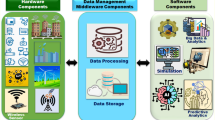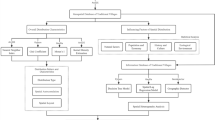Abstract
The measurement of network topology through various spatial topological indices like Alpha, Beta and Gamma are widely used for spatial data analysis. However, explaining the classification of the network topology of a city based on Alpha, Beta and Gamma indices is not conclusive, as the result of individual indices are different. To address an efficient classification of network topology, a Modified Synthetic Indicator (MSI) has been proposed and criticised over existing synthetic indicators based on the Composite Weighted Connectivity Index (CWCI), the linear combination of Alpha, Beta and Gamma indices. Application of the proposed MSI in micro-level (ward level) classification of network topology i.e., road network connectivity, has been verified in Agartala City and calibrates the efficiency of CWCI over Alpha, Beta and Gamma indices. The study reveals that the proposed CWCI is more robust than any individual graph-theoretic measure.

Source: Prepared by the authors, 2021; Data extracted from DIVAGIS and handheld GPS receiver

Source: Prepared by the Authors, 2021; data collected from the field through a handheld GPS receiver

Source: Prepared by the Authors, 2021

Source: Prepared by the authors, 2022; Data extracted from a field study by using a handheld GPS receiver
Similar content being viewed by others
Data Availability
Spatial data (.gpx,.kml/.shp format) share upon reasonable request.
Code Availability
Not Applicable.
References
Xie F, Levinson D (2007) Measuring the structure of road networks. Geogr Anal 39(3):336–356
Shi Y (2022) Advances in big data analytics: theory, algorithm and practice. Springer, Singapore
Olson DL, Shi Y, Shi Y (2007) Introduction to business data mining. McGraw-Hill/Irwin, New York 10:2250–2254
Shi Y, Tian Y, Kou G, Peng Y, Li J (2011) Optimization based data mining: theory and applications. Springer
Tien JM (2017) Internet of things, real-time decision making, and artificial intelligence. Ann Data Sci 4(2):149–178
Sreelekha MG, Krishnamurthy K, Anjaneyulu MV (2016) Interaction between road network connectivity and spatial pattern. Proced Technol 24:131–139. https://doi.org/10.1016/j.protcy.2016.05.019
Al-dam HA (2015) Measuring the accessibility of road networks: Diwaniya/Iraq as case study. Int J Curr Res 2(3):173–182
Rodrigue JP, Slack B (2017) The geography of transport systems. Routledge, New York
Kansky KJ (1963) Structure of transportation networks: relationships between network geometry and regional characteristics. University of Chicago, Chicago
Casali Y, Heinimann HR (2019) A topological analysis of growth in the Zurich road network. Comput Environ Urban Syst 75:244–253. https://doi.org/10.1016/j.compenvurbsys.2019.01.010
Ding R (2019) The complex network theory-based urban land-use and transport interaction studies. Complexity 19(1):1–15. https://doi.org/10.1155/2019/4180890
Orellana D, Guerrero ML (2019) Exploring the influence of road network structure on the spatial behaviour of cyclists using crowdsourced data. Environ Plan B: Urban Analyt City Sci 46(7):1314–1330. https://doi.org/10.1177/2399808319863810
Yang Y, Li D, Li X (2019) Public transport connectivity and intercity tourist flows. J Travel Res 58(1):25–41. https://doi.org/10.1177/0047287517741997
Wang L, Xue X, Zhao Z, Wang X (2018) The impacts of transportation infrastructure on sustainable development: emerging trends and challenges. Int J Environ Res Public Health 15(6):1–24. https://doi.org/10.3390/ijerph15061172
Kumar R, Parida P, Madhu E, Bharat Kumar AV (2017) Does Connectivity index of transport network have impact on delay of driver? World Confer Transp Res 25:2352–1465
Strano E, Giometto A, Shai S, Bertuzzo E, Mucha PJ, Rinaldo A (2017) The scaling structure of the global road network. R Soc Open Sci 4(10):1–11. https://doi.org/10.1098/rsos.170590
Stinga VG (2017) Analysis regarding the transport network models. Case study. In: IOP conf. series: materials science and engineering. Proceedings Journal of Physics, Romania, pp 1–6. https://doi.org/10.1088/1757-899X/227/1/012124
Zhao F, Sun H, Wu J, Gao Z, Liu R (2016) Analysis of road network pattern considering population distribution and central business district. PLoS ONE 11(3):1–17. https://doi.org/10.1371/journal.pone.0151676
Jamroz K, Kustra W, Budzynski M, Zukowska J (2014) Pedestrian Protection, speed enforcement and road network structure the key action for implementing Poland’s Vision zero. Transp Res Procedia 14:3905–3914. https://doi.org/10.1016/j.trpro.2016.05.479
Chen S, Claramunt C, Ray C (2014) A spatio-temporal modelling approach for the study of the connectivity. J Transp Geogr 36:12–23
Rodrigue JP, Comtois C, Slack B (2013) The geography of transport systems. Routledge, New York
Hadas Y, Rossi R, Gastaldi M, Gecchele G (2014) Public Transport systems’ connectivity: spatiotemporal analysis and failure detection. Transp Res Procedia 3:309–318. https://doi.org/10.1016/j.trpro.2014.10.011
Mitra S, Hore S, Roy S, Debbarma D (2021) Micro-level classification of road network connectivity of Agartala Municipal Corporation. Geogr Rev India 83(2):214–234
Jaroca M, Glinska E (2017) The state and prospects for development of railway transport in Eastern Poland- Secondary data analysis. Procedia Eng 182(3):299–305. https://doi.org/10.1016/j.proeng.2017.03.198
Roy S, Hore S, Mitra S, Chaberek G (2022) Delineating regional differentiation on the development. Transp Probl. https://doi.org/10.20858/tp.2022.17.3.13
Mitra S, Roy S, Hore S (2022) Assessment and forecasting of the urban dynamics through lulc based mixed model: evidence from Agartala, India. GeoJournal 87(4):1–24. https://doi.org/10.1007/s10708-022-10730-4
Sen S, Debbarma C, De SK, Mitra S (2015) Impact of faults on landslide in the Atharamura Hill (along the NH 44), Tripura. Environ Earth Sci 73(19):5289–5298. https://doi.org/10.1007/s12665-014-3778-4
Santra A, Mitra S, Debbarma D (2018) Impact of urbanization on land use changes in Agartala City, India. Res J Hum Soc Sci 9(2):1–8
Lea Associates South Asia Pvt. Ltd (2006) City development plan-Agartala. Urban Development Department, Government of Tripura, Agartala
Mitra S, Debbarma D, Santra A, Roy S (2018) Road network system in Agartala municipal corporation: a geographical analysis. Indian J Reg Sci 1:66–77
Goretti A, Sarli V (2006) Road network and damaged buildings in urban areas: short and long-term interaction. Bull Earthq Eng 4(2):159–175. https://doi.org/10.1007/s10518-006-9004-3
Cascetta E (2001) Transportation Supply Models. In: Cascetta E (ed) Transportation systems engineering: theory and methods. Applied optimization. Springer, Boston, pp 23–94. https://doi.org/10.1007/978-1-4757-6873-2_2
Toint PL (1998) Transportation modelling and operations research: a fruitful connection. In: Labbe M, Laporte G, Tanczos K, Toint P (eds) Operations research and decision aid methodologies in traffic and transportation management. Springer, Berlin, Heidelberg, pp 3–10. https://doi.org/10.1007/978-3-662-03514-6_1
Rawat DS, Sharma S (1997) The development of a road network and its impact on the growth of infrastructure: a study of Almora district in the central Himalaya. Mt Res Dev 17(2):117–126. https://doi.org/10.2307/3673826
Hashidu RB, Abbas AM, Jimme MA (2020) Analysis of road transport dynamics in Gombe City, Gombe State, Nigeria. Am J Sci Eng Res 29–38
Haque M, Alam J (2020) Micro-level analysis of road connectivity and its spatial variation in the Kolkata Municipal Corporation (KMC) area. In: Bandyopadhyay S, Pathak CR, Dentinho TP (eds) Urbanization and regional sustainability in South Asia: socio-economic drivers, environmental pressures and policy responses. Springer, Cham, pp 157–176. https://doi.org/10.1007/978-3-030-23796-7
Abbas AM, Hashidu RB (2019) Transportation network analysis, connectivity and accessibility indices in North East, Nigeria. J Res Hum Soc Sci 7(9):60–66
Hack J, Adey BT (2019) Estimation of traffic flow changes using networks in networks approaches. Appl Netw Sci 4(28):1–26. https://doi.org/10.1007/s41109-019-0139-y
Mistry AH, Haque M (2016) Geo-spatial analysis of road connectivity and urbanization induced traffic congestion in Baruipur municipality, West Bengal. Geogr Rev India 269–285
Derrible S, Kennedy CE (2011) Applications of graph theory and network science to transit network design. Transp Rev 31(4):495–519. https://doi.org/10.1080/01441647.2010.543709
Greco S, Ishizaka A, Tasiou M, Torrisi G (2019) On the methodological framework of composite indices: a review of the issues of weighting, aggregation, and robustness. Soc Indic Res 141:61–94. https://doi.org/10.1007/s11205-017-1832-9
Saxena HM (2010) Transport geography. Rawat, Jaipur
Black WR (2003) Transportation: a geographical analysis. Guilford Publications, New York
Reyes-Silva JD, Zischg J, Klinkhamer C, Suresh P, Rao C, Sitzenfrei R, Krebs P (2020) Centrality and shortest path length measures for the functional analysis of urban drainage networks. Appl Netw Sci 5(1):1–14. https://doi.org/10.1007/s41109-019-0247-8
Marshall S (2015) Line structure representation for road network analysis. J Trans Land Use 9(1). https://doi.org/10.5198/jtlu.2015.744
Ducruet C, Rodrigue JP (2020) Graph theory: measures and indices. In: Rodrigue JP (ed) The geography of transport systems. Routledge, New York
Alvi Z (2011) Statistical geography. Rawat Publications, Jaipur
Das R, Tripathy BC (2022) Separation axioms on spatial topological space and spatial data analysis. Ann Data Sci 59:1–13. https://doi.org/10.1007/s40745-022-00393-w
Liu F, Shi Y, Chen Z (2021) Intelligence quotient test for smart cities in the United States. J Urban Plan Dev 147(1):04020053
Boruah M, Roy S, Hore S, Mitra S, Chaberek G (2023) Micro-level classification of road network connectivity through an entropy based synthetic indicator: a case study of Kolkata Municipal Corporation
Acknowledgements
The authors are grateful to Department of Science and Technology (DST), Ministry of Science and Technology, Government of India for financial support to carry out the research.
Funding
This publication resulted (in part) from the research project supported by the Department of Science and Technology (DST), Ministry of Science and Technology, Government of India. The project entitled "Identification, Assessment and Model Building of Urban Morphology using Geospatial Techniques: A Study of Border City Agartala"(File No. NRDMS/UG/S.Mitra/Tripura/e-10/2019 (G) dated 15.05.2019). The content is solely the authors' responsibility and does not necessarily represent the official views of the DST, New Delhi, India.
Author information
Authors and Affiliations
Contributions
All authors have equal contributions.
Corresponding author
Ethics declarations
Conflict of Interest
There is no competing interest. There is no financial and non-financial interest to disclose. There are no patents to disclose. There are no additional relationships to disclose.
Ethical Statement
I hereby declare that this manuscript is the result of our independent creation, developed under the guidance and comments of the reviewers. Except for the quoted contents, this manuscript does not contain any research achievements that have been published or written by other individuals or groups. I confirm that there are four authors namely SamratHore, StabakRoy, MalabikaBoruah, SaptarshiMitra of this manuscript. The legal responsibility for this statement shall be borne by me.
Additional information
Publisher's Note
Springer Nature remains neutral with regard to jurisdictional claims in published maps and institutional affiliations.
Rights and permissions
Springer Nature or its licensor (e.g. a society or other partner) holds exclusive rights to this article under a publishing agreement with the author(s) or other rightsholder(s); author self-archiving of the accepted manuscript version of this article is solely governed by the terms of such publishing agreement and applicable law.
About this article
Cite this article
Hore, S., Roy, S., Boruah, M. et al. Spatial Data Analysis for Robust Classification of Network Topology Through Synthetic Combinatorics. Ann. Data. Sci. (2024). https://doi.org/10.1007/s40745-024-00523-6
Received:
Revised:
Accepted:
Published:
DOI: https://doi.org/10.1007/s40745-024-00523-6




